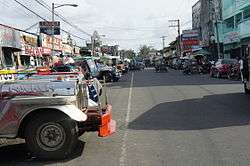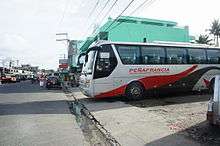Gubat, Sorsogon
Gubat, officially the Municipality of Gubat (Gubatnon: Banwaan sa Gubat; Tagalog: Bayan ng Gubat), is a 2nd class municipality in the province of Sorsogon, Philippines. According to the 2015 census, it has a population of 59,534 people.[3]
Gubat | |
|---|---|
| Municipality of Gubat | |
 Downtown area | |
 Seal | |
| Motto(s): Gubat is for Life | |
 Map of Sorsogon with Gubat highlighted | |
OpenStreetMap 
| |
.svg.png) Gubat Location within the Philippines | |
| Coordinates: 12°55′N 124°07′E | |
| Country | |
| Region | Bicol Region (Region V) |
| Province | Sorsogon |
| District | 2nd District |
| Founded | June 13, 1764 |
| Barangays | 42 (see Barangays) |
| Government | |
| • Type | Sangguniang Bayan |
| • Mayor | Sharon Rose G. Escoto |
| • Vice Mayor | Sixto F. Estareja |
| • Congressman | Ma. Bernardita B. Ramos |
| • Electorate | 38,282 voters (2019) |
| Area | |
| • Total | 134.51 km2 (51.93 sq mi) |
| Population (2015 census)[3] | |
| • Total | 59,534 |
| • Density | 440/km2 (1,100/sq mi) |
| • Households | 13,454 |
| Demonym(s) | Gubatnons |
| Economy | |
| • Income class | 2nd municipal income class |
| • Poverty incidence | 30.53% (2015)[4] |
| • Revenue (₱) | 128,908,204.74 (2016) |
| Time zone | UTC+8 (PST) |
| ZIP code | 4710 |
| PSGC | |
| IDD : area code | +63 (0)56 |
| Climate type | tropical rainforest climate |
| Native languages | Sorsoganon Tagalog |
| Website | www |
Gubat is pronounced with the accent on the second syllable. The people who live here speak the Gubat language which is also a dialect of Waray-Waray of Eastern Visayas, a Southern Sorsoganon sub-language and they were called Gubatnons.
Geography
Gubat is in the south-eastern part of Luzon Island, along the coast of the Pacific Ocean on the Bicol Peninsula. It is the third largest town in the province of Sorsogon. It is divided into 2 districts: the North District and South District.
Barangays
Gubat is politically subdivided into 42 barangays.
- Ariman
- Bagacay
- Balud Del Norte (Poblacion)
- Balud Del Sur (Poblacion)
- Benguet
- Bentuco
- Beriran
- Buenavista
- Bulacao
- Cabigaan
- Cabiguhan
- Carriedo
- Casili
- Cogon
- Cota Na Daco (Poblacion)
- Dita (Estillero)
- Jupi (Estillero)
- Lapinig
- Luna-Candol (Poblacion)
- Manapao
- Manook (Poblacion)
- Naagtan
- Nato
- Nazareno
- Ogao
- Paco
- Panganiban (Poblacion)
- Paradijon (Poblacion)
- Patag
- Payawin
- Pinontingan (Poblacion)
- Rizal
- San Ignacio
- Sangat
- Santa Ana
- Tabi
- Tagaytay
- Tigkiw
- Tiris
- Togawe
- Union
- Villareal
Barangays with (Poblacion) indicate that barangay is part of the town proper or poblacion
Climate
| Climate data for Gubat, Sorsogon | |||||||||||||
|---|---|---|---|---|---|---|---|---|---|---|---|---|---|
| Month | Jan | Feb | Mar | Apr | May | Jun | Jul | Aug | Sep | Oct | Nov | Dec | Year |
| Average high °C (°F) | 27 (81) |
28 (82) |
29 (84) |
31 (88) |
31 (88) |
30 (86) |
29 (84) |
29 (84) |
29 (84) |
29 (84) |
29 (84) |
28 (82) |
29 (84) |
| Average low °C (°F) | 22 (72) |
21 (70) |
22 (72) |
23 (73) |
24 (75) |
25 (77) |
25 (77) |
25 (77) |
25 (77) |
24 (75) |
23 (73) |
23 (73) |
24 (74) |
| Average precipitation mm (inches) | 65 (2.6) |
44 (1.7) |
42 (1.7) |
39 (1.5) |
87 (3.4) |
150 (5.9) |
184 (7.2) |
153 (6.0) |
163 (6.4) |
154 (6.1) |
127 (5.0) |
100 (3.9) |
1,308 (51.4) |
| Average rainy days | 13.9 | 9.2 | 11.0 | 12.5 | 19.6 | 24.3 | 26.5 | 25.0 | 25.5 | 24.4 | 19.4 | 15.1 | 226.4 |
| Source: Meteoblue [5] | |||||||||||||
History
Gubat was originally a big barrio of Bulusan, inhabited by a few Tagalogs, Visayans and Albayanons who travelled on foot to hunt wild animals. These people built their homes close to the shore and called their location Buri, which today is the barrio of Buenavista. In 1764, Gubat finally became a town with Don Pedro Manook, the first Teniente del Barrio, also becoming the first gobernadorcillo. The town proper is named after Don Pedro Manook.
The word "gúbat" means forest in Tagalog. However, the name applied to the town is derived from the verb "guinobat", a term used by the natives which means "raided". In the early days when Christians and Muslims were constantly at odds, Muslim pirates would come in from the southern seas to raid the town. Because of the frequent raids, the town was referred to as "guinobat" which eventually became "Gubat". Legend has it that during one of those raids, the pastor along with the townspeople held up a statue of St. Anthony to ward off the attack, praying for a miracle. In one account, it was said that the child Jesus in St. Anthony's arms drove back the pirates. St. Anthony of Padua became the town's patron saint and his feast day is lavishly celebrated as an official parish and town holiday every 13 June.
The town settlers had to move a number of times before finally deciding to settle at a place they considered safe and peaceful. Eventually, they began to expand, laying out permanent streets, the first of which are what we now know as Luna and Calderon Streets.
The main parish church itself has an interesting history. In 1768, the people decided to build a church. The locals, being poor, urged the town captain, Don Juan Bonifacio, to require all men to contribute one cubic meter of "talaksan" (coral stone) apiece. It took ten years of preparation and it was not until 1778 that construction finally started.
Although it has since undergone several renovations, the church foundation is still the original one built in 1778. The rectory is the oldest and one of the only two remaining rectories dating back that far in the entire Bicol region.
In November 2006, Gubat became the site of a scientific expedition by astronomers Dr. Armando Lee, Bamm Gabriana, and Rochelle Derilo to observe the rare Mercury transit. Gubat was the best town in Luzon to observe the event.[6]
Demographics
|
| ||||||||||||||||||||||||||||||||||||||||||||||||
| Source: Philippine Statistics Authority[3][7][8][9] | |||||||||||||||||||||||||||||||||||||||||||||||||
Religions
Although, the dominant religion is Roman Catholicism, there are Gubatnons devoted to:
- Iglesia ni Cristo
- Protestant Evangelical Baptist
- Islam (some traders and residents)
- Buddhism (Chinese traders and residents)
- Members Church of God International
- The Church of Jesus Christ of Latter Day Saints
- Seventh Day Adventist
- Baptist
Economy
The main livelihoods of the people, then and now, are agriculture and fishing. Harvest times for rice crops are from April to May, and December. Fishing is year-round. Forestry products are also source of income here.
Transportation

Gubat can be reached mostly through land transport from Manila by bus, taking about 12 hours. There are several bus companies that operates daily from Manila to Gubat and vice versa: Alps The Bus Inc., JVH Transport/Pamar, Elavil Tours Phils. Inc., Raymond Transportation, St.Jude Transit, CUL Transport, DLTBCo., Penafrancia Tours/RSL/Isarog and Philtranco.
There are also jeepneys that provide transportation to Sorsogon City, Bulusan, Barcelona, Prieto-Diaz, Casiguran, Irosin and local barangays like Tigkiw, Bentuco and Benguet. Local tricycles travels to the innermost barangays like Union, Bulacao, Rizal, Cabigaan and Sangat.
Communications
The town has modern and efficient communications facilities including cellular mobile phone
Telephone Company
Cable TV
- ANH Cable TV
- DCTV Cable With Broadband
Satellite Cable
Radio Station
- DWPS FM 91.1 mHz "Rainbow Radio"
- Padaba(Gubat)105.1 mHz
Sports
Gubat is slowly being recognized as the only beginner friendly surfing spot in the province of Sorsogon. The sand bottom beach breaks of Barangays Ariman and Buenavista (Dangkalan and Rizal Beach) produce 2 to 5 feet waves from September to May. With the formation of Gubat Bay Surfers by Bidge Villarroya and surfboards donated by the Local Government Unit under Mayor Ding Ramos, surfing is more accessible to the local population and tourists alike. The new group of Gubat Sorsogon Surfer's Association, still under Bidge Villarroya is now performing well in the National Surf Competition Scene, winning 5 national surf championships and numerous finalist positions. Gubat is the Top 1 in Ngo Sport Airsoft Society by the NGO Bicol Sorsogon Chapter.
Festivals
The town celebrates its Ginubat Festival annually every June 1–13 in honor of its patron, St. Anthony of Padua. It is also the foundation of the town.
Education
Primary education
Includes:
- Gubat North Central School
- Gubat South Central School
- Aguinaldo Elementary School
- Ariman Elementary School
- Bagacay Elementary School
- Benguet Elementary School
- Bentuco Elementary School
- Beriran Elementary School
- Bongsaran Elementary School
- Bonifacio Elementary School
- Buenavista Elementary School
- Bulacao Elementary School
- Cabigaan Elementary School
- Cabiguhan Elementary School
- Carriedo Elementary School
- Casili Elementary School
- Cogon Elementary School
- Dita Elementary School
- Jupi Elementary School
- Landmark Baptist Academy
- Lapinig Elementary School
- Manapao Elementary School
- Naagtan Elementary School
- Nato Elementary School
- Nazareno Elementary School
- Ogao Elementary School
- Paco Elementary School
- Patag Elementary School
- Payawin Elementary School
- Rizal Elementary School
- San Ignacio Elementary School
- Sangat Elementary School
- Santa Ana Elementary School
- San Ignacio Elementary School
- Tabi Elementary School
- Tagaytay Elementary School
- Tigkiw Elementary School
- Tiris Elementary School
- Togawe Elementary School
- Union Elementary School
- Villareal Elementary School
Secondary education
Includes:
- St. Louise De Marillac College of Sorsogon - St. Anthony Gubat Campus (formerly: St. Anthony Academy)
- Gubat National High School
- Landmark Baptist Academy
- Bagacay National High School
- Bentuco National High School
- Bulacao National High School
- Jupi National High School
- Rizal National High School
Tertiary education
- Bicol University (Gubat Campus)
- Data Base Technology Computer School
References
- "Municipality". Quezon City, Philippines: Department of the Interior and Local Government. Retrieved 31 May 2013.
- "Province: Sorsogon". PSGC Interactive. Quezon City, Philippines: Philippine Statistics Authority. Retrieved 12 November 2016.
- Census of Population (2015). "Region V (Bicol Region)". Total Population by Province, City, Municipality and Barangay. PSA. Retrieved 20 June 2016.
- "PSA releases the 2015 Municipal and City Level Poverty Estimates". Quezon City, Philippines. Retrieved 1 January 2020.
- "Gubat, Sorsogon : Average Temperatures and Rainfall". Meteoblue. Retrieved 29 December 2018.
- Bobby Labalan (7 November 2006). "Sorsogon town 'best spot' to observe cosmic event". Philippine Daily Inquirer. Archived from the original on 25 July 2013. Retrieved 25 July 2013.
- Census of Population and Housing (2010). "Region V (Bicol Region)". Total Population by Province, City, Municipality and Barangay. NSO. Retrieved 29 June 2016.
- Censuses of Population (1903–2007). "Region V (Bicol Region)". Table 1. Population Enumerated in Various Censuses by Province/Highly Urbanized City: 1903 to 2007. NSO.
- "Province of Sorsogon". Municipality Population Data. Local Water Utilities Administration Research Division. Retrieved 17 December 2016.
External links
| Wikimedia Commons has media related to Gubat, Sorsogon. |